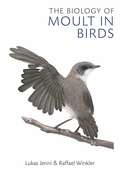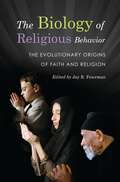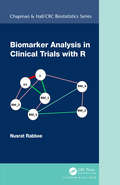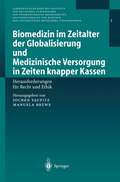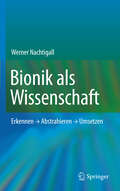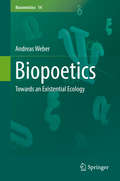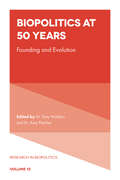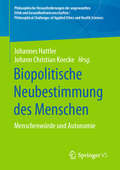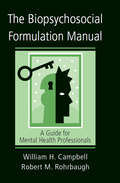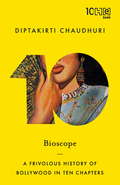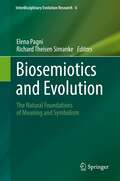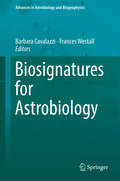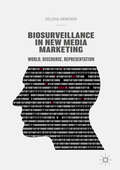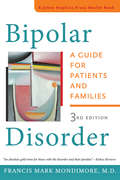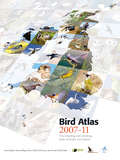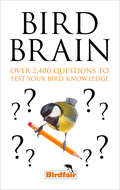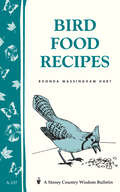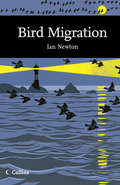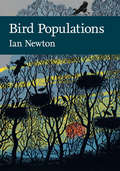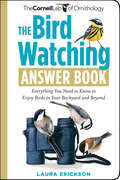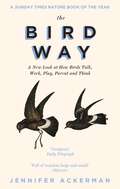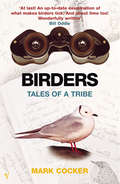- Table View
- List View
The Biology of Moult in Birds
by Lukas Jenni Raffael WinklerFeathers are amazing structures unique to birds and, for a variety of reasons, they need to be renewed periodically as a whole in a process called moult. During this process, all of the functions of plumage are impaired and most aspects of a bird's life are affected. Every moult determines a bird's appearance anew, and restores plumage efficacy for flight and insulation. Moult profoundly affects physiology and the organization of the annual cycle, and it constrains reproduction and migration. Given these major impacts, which are equal to the other annual challenges of reproduction and migration, it is surprising that research on moult has largely been so neglected a subject. Lukas Jenni and Raffael Winkler have brought together the widely scattered results of studies on the processes and consequences of moult in birds. This book opens with an overview of the functions of plumage, and of feather maintenance and feather wear, and then introduces the two functions of moult: replacement of worn feathers and adjustment of plumage characteristics and appearance. The body of the book then examines feather-growth and the physiology, energetics and control of moult, and how various other physiological processes interact with moult and may compensate for its costs. Significantly, the authors explain how variations in moult and feather quality affect a bird's overall plumage quality, and they highlight the resulting consequences in terms of physical performance, appearance and signalling. Finally, there is a review of all the various solutions that birds have developed to fit moult into the annual cycle.This long-awaited book covers for the first time all aspects of the biology of moult and fills an important gap in the literature, completing our understanding of how the most important annual events in a bird's life fit together into a coherent whole. It draws on a wide range of information – from penguins to small passerines, from raptors to wildfowl – to highlight the variety of the subject and to pinpoint the many gaps in our knowledge along with avenues for fruitful further research.
The Biology of Religious Behavior: The Evolutionary Origins of Faith and Religion (Non-ser.)
by Jay R. FeiermanOffers a fresh and detailed take on the evolution of religious behavior from a biobehavioral perspective, promoting a new understanding that may help build bridges across the religious divide.There has been much recent interest in the study of religion from the perspective of Darwinian evolution. The Biology of Religious Behavior: The Evolutionary Origins of Faith and Religion offers a broad overview of the topic, written by internationally recognized experts. In addition to its primary focus on religious behavior, the book addresses other important aspects of religion, such as values, beliefs, and emotions as they affect behavior. The contributors approach the evolution of religion by examining the behavior of individuals in their everyday lives. After describing various religious behaviors, the contributors consider the behaviors with reference to their evolutionary history, development during the lifetime of the individual, proximate causes, and adaptive value. Happily, this foray into understanding religion from a biobehavioral perspective demonstrates that, at the biological and behavioral levels, what unites the different religions of the world is far greater than what divides them.
Biomarker Analysis in Clinical Trials with R (Chapman & Hall/CRC Biostatistics Series)
by Nusrat RabbeeThe world is awash in data. This volume of data will continue to increase. In the pharmaceutical industry, much of this data explosion has happened around biomarker data. Great statisticians are needed to derive understanding from these data. This book will guide you as you begin the journey into communicating, understanding and synthesizing biomarker data. -From the Foreword, Jared Christensen, Vice President, Biostatistics Early Clinical Development, Pfizer, Inc. Biomarker Analysis in Clinical Trials with R offers practical guidance to statisticians in the pharmaceutical industry on how to incorporate biomarker data analysis in clinical trial studies. The book discusses the appropriate statistical methods for evaluating pharmacodynamic, predictive and surrogate biomarkers for delivering increased value in the drug development process. The topic of combining multiple biomarkers to predict drug response using machine learning is covered. Featuring copious reproducible code and examples in R, the book helps students, researchers and biostatisticians get started in tackling the hard problems of designing and analyzing trials with biomarkers. Features: Analysis of pharmacodynamic biomarkers for lending evidence target modulation. Design and analysis of trials with a predictive biomarker. Framework for analyzing surrogate biomarkers. Methods for combining multiple biomarkers to predict treatment response. Offers a biomarker statistical analysis plan. R code, data and models are given for each part: including regression models for survival and longitudinal data, as well as statistical learning models, such as graphical models and penalized regression models. Nusrat Rabbee is a biostatistician and data scientist at Rabbee & Associates, where she creates innovative solutions to help companies accelerate drug and diagnostic development for patients. Her research interest lies in the intersection of data science and personalized medicine. She has extensive experience in bioinformatics, clinical statistics and high-dimensional data analyses. She has co-discovered the RLMM algorithm for genotyping Affymetrix SNP chips and co-invented a high-dimensional molecular signature for cancer. She has spent over 17 years in the pharmaceutical and diagnostics industry focusing on biomarker development. She has taught statistics at UC Berkeley for 4 years.
Biomarker Analysis in Clinical Trials with R (Chapman & Hall/CRC Biostatistics Series)
by Nusrat RabbeeThe world is awash in data. This volume of data will continue to increase. In the pharmaceutical industry, much of this data explosion has happened around biomarker data. Great statisticians are needed to derive understanding from these data. This book will guide you as you begin the journey into communicating, understanding and synthesizing biomarker data. -From the Foreword, Jared Christensen, Vice President, Biostatistics Early Clinical Development, Pfizer, Inc. Biomarker Analysis in Clinical Trials with R offers practical guidance to statisticians in the pharmaceutical industry on how to incorporate biomarker data analysis in clinical trial studies. The book discusses the appropriate statistical methods for evaluating pharmacodynamic, predictive and surrogate biomarkers for delivering increased value in the drug development process. The topic of combining multiple biomarkers to predict drug response using machine learning is covered. Featuring copious reproducible code and examples in R, the book helps students, researchers and biostatisticians get started in tackling the hard problems of designing and analyzing trials with biomarkers. Features: Analysis of pharmacodynamic biomarkers for lending evidence target modulation. Design and analysis of trials with a predictive biomarker. Framework for analyzing surrogate biomarkers. Methods for combining multiple biomarkers to predict treatment response. Offers a biomarker statistical analysis plan. R code, data and models are given for each part: including regression models for survival and longitudinal data, as well as statistical learning models, such as graphical models and penalized regression models. Nusrat Rabbee is a biostatistician and data scientist at Rabbee & Associates, where she creates innovative solutions to help companies accelerate drug and diagnostic development for patients. Her research interest lies in the intersection of data science and personalized medicine. She has extensive experience in bioinformatics, clinical statistics and high-dimensional data analyses. She has co-discovered the RLMM algorithm for genotyping Affymetrix SNP chips and co-invented a high-dimensional molecular signature for cancer. She has spent over 17 years in the pharmaceutical and diagnostics industry focusing on biomarker development. She has taught statistics at UC Berkeley for 4 years.
Biomedizin im Zeitalter der Globalisierung und Medizinische Versorgung in Zeiten knapper Kassen: Herausforderungen für Recht und Ethik (Veröffentlichungen des Instituts für Deutsches, Europäisches und Internationales Medizinrecht, Gesundheitsrecht und Bioethik der Universitäten Heidelberg und Mannheim #1)
by Jochen Taupitz Manuela BreweIm Sommersemester 1999 veranstaltete das Institut für Deutsches, Europäisches und Internationales Medizinrecht, Gesundheitsrecht und Bioethik (IMGB) eine eigenständigen Vortragsreihe zu dem Thema "Medizinische Versorgung in Zeiten knapper Kassen". In sieben Vorträgen setzen sich Referenten aus Wissenschaft und Praxis mit dem aktuellen Problem der Ressourcenknappheit und Ressourcenverteilung im Gesundheitswesen auseinander. Die Beiträge spannen einen weiten Bogen von philosophischen, gesellschaftspolitischen, ökonomischen und juristischen Grundfragen bis hin zu ganz praktischen Problemen in der Organisation der gesetzlichen Krankenversicherungen und bei der Tätigkeit des Arztes "vor Ort".
Bionik als Wissenschaft: Erkennen - Abstrahieren - Umsetzen
by Werner NachtigallDer Begriff „BIONIK“ wird gerne als Kunstwort gekennzeichnet, zusammengesetzt aus BIOlogie und TechNIK. Bionik stellt einerseits ein Fach dar, in dem geforscht und ausgebildet wird, und kennzeichnet andererseits eine Sichtweise, nämlich die des „Lernens von der Natur für die Technik“. Darüber sind in der Zwischenzeit neben populär wissenschaftlichen Werken eine Reihe von Fachbüchern erschienen. Werner Nachtigall hat darin mit der 2. Auflage seines bei Springer erschienenen Buchs „BIONIK – Grundlagen und Beispiele für Ingenieure und Naturwissenschaftler“ einen Meilenstein gesetzt. In diesem Buch kennzeichnet er die Untergliederung des Fachs und bespricht detailliert dessen Forschungsgegenstände. Dagegen fehlte bislang eine Darstellung, die sich mit den erkenntnistheoretischen Grundlagen wie mit der pragmatischen Vorgehensweise der Bionik systematisch befasst, die ja mit der ihr eigenen Prinzip-Abstraktion zwischen der belebten Welt als Vor-Bild und der technischen Umsetzung als Ab-Bild vermitteln will. Das vorliegende Werk schließt diese Lücke mit drei großen Abschnitten: Biologische Basis: Erforschen, Beschreiben, Beurteilen. – Abstraktion biologischer Befunde: Herausarbeiten allgemeiner Prinzipien. – Umsetzung in die Technik: Prinzipvergleich, Konzeptuelles, Vorgehensweise.
Biopoetics: Towards an Existential Ecology (Biosemiotics #14)
by Andreas WeberMeaning, feeling and expression – the experience of inwardness – matter most in human existence. The perspective of biopoetics shows that this experience is shared by all organisms. Being alive means to exist through relations that have existential concern, and to express these dimensions through the body and its gestures. All life takes place within one poetic space which is shared between all beings and which is accessible through subjective sensual experience. We take part in this through our empirical subjectivity, which arises from the experiences and needs of living beings, and which makes them open to access and sharing in a poetic objectivity. Biopoetics breaks free from the causal-mechanic paradigm which made biology unable to account for mind and meaning. Biology becomes a science of expression, connection and subjectivity which can understand all organisms including humans as feeling agents in a shared ecology of meaningful relations, embedded in a symbolical and material metabolism of the biosphere.
Biopolitics at 50 Years: Founding and Evolution (Research in Biopolitics #13)
by Tony Wohlers, Amy FletcherBiopolitics at 50 Years: Founding and Evolution explores the study of biology and politics through the prism of fifty years of experience presenting current research that illustrates the nature and evolution of biopolitics. Containing substantive chapters that address many issues using different methodologies, Biopolitics at 50 Years draws on different theoretical perspectives to advance the field. Beginning with a reflection on the origin and scholarly emphasises of biopolitics and concludes with future prospects in the field, this 13th volume of Research in Biopolitics explores the broad scale theoretical consideration of politics based on evolutionary factors affecting the political realm physiological factors affecting political behavior, public policy issues affected by biology and how human nature affects outcomes of policy making.
Biopolitics at 50 Years: Founding and Evolution (Research in Biopolitics #13)
by Tony Wohlers Amy FletcherBiopolitics at 50 Years: Founding and Evolution explores the study of biology and politics through the prism of fifty years of experience presenting current research that illustrates the nature and evolution of biopolitics. Containing substantive chapters that address many issues using different methodologies, Biopolitics at 50 Years draws on different theoretical perspectives to advance the field. Beginning with a reflection on the origin and scholarly emphasises of biopolitics and concludes with future prospects in the field, this 13th volume of Research in Biopolitics explores the broad scale theoretical consideration of politics based on evolutionary factors affecting the political realm physiological factors affecting political behavior, public policy issues affected by biology and how human nature affects outcomes of policy making.
Biopolitische Neubestimmung des Menschen: Menschenwürde und Autonomie (Philosophische Herausforderungen der angewandten Ethik und Gesundheitswissenschaften/ Philosophical Challenges of Applied Ethics and Health Sciences)
Die Allgemeine Erklärung der Menschenrechte und das Grundgesetz der Bundesrepublik Deutschland haben die Menschenwürde als Höchstwert und oberstes Prinzip verankert. Biopolitischen Eingriffen durch den Staat sollte damit eine absolute Grenze gesetzt werden. Die Unbestimmtheit der Menschenwürde hat jedoch in den bioethischen Debatten der letzten Jahrzehnte dazu geführt, dass die Vorrangstellung der Menschenwürde in Frage gestellt wurde oder sich Vertreter entgegengesetzter Positionen beide gleichermaßen auf die Würde des Menschen berufen konnten. So stehen Eugenik und Euthanasie – in liberalem Gewande – als legitime Optionen wieder auf der Tagesordnung. Dies ist einerseits eine Problemanzeige und andererseits der Hinweis darauf, das unterschiedliche Lager unter Würde unterschiedliches verstehen. Der vorliegende Band diskutiert vorranging das Verhältnis von Menschenwürde und Autonomie als den zentralen Argumentationsgrundlagen dieser Debatte. Dabei wird der Frage nachgegangen, inwieweit es gerechtfertigt ist, den Würdebegriff durch den Autonomiebegriff zu ersetzen, bzw. ob der Würdebegriff Aspekte des Autonomiebegriffs integrieren oder ausschließen muss, um dem Grundanliegen der Allgemeinen Erklärung der Menschenrechte und des Grundgesetzes der Bundesrepublik Deutschland gerecht zu werden, ohne Abstriche am Grundsatz der Unverfügbarkeit zu riskieren.
The Biopsychosocial Formulation Manual: A Guide for Mental Health Professionals
by William H. Campbell Robert M. RohrbaughBased on George Engel’s model, The Biopsychosocial Formulation Manual presents ways to help psychiatry residents and students effectively gather and organize patient data to arrive at a complete mental health history in a limited timeframe. While most current models only take one factor into account, Campbell and Rohrbaugh emphasize and analyze three essential components (biological, social, and psychological). The process of identifying pertinent data for each component of the biopsychosocial formulation is explicated in detail. A separate section outlines how to use the biopsychosocial formulation to generate treatment recommendations. This volume includes a complete package for practicing the biopsychosocial method; this easy-to-use guide includes a data record sheet and a companion CD to facilitate organization and assessment, appealing to both the psychiatric professional and the trainee.
The Biopsychosocial Formulation Manual: A Guide for Mental Health Professionals
by William H. Campbell Robert M. RohrbaughBased on George Engel’s model, The Biopsychosocial Formulation Manual presents ways to help psychiatry residents and students effectively gather and organize patient data to arrive at a complete mental health history in a limited timeframe. While most current models only take one factor into account, Campbell and Rohrbaugh emphasize and analyze three essential components (biological, social, and psychological). The process of identifying pertinent data for each component of the biopsychosocial formulation is explicated in detail. A separate section outlines how to use the biopsychosocial formulation to generate treatment recommendations. This volume includes a complete package for practicing the biopsychosocial method; this easy-to-use guide includes a data record sheet and a companion CD to facilitate organization and assessment, appealing to both the psychiatric professional and the trainee.
Bioscope: A Frivolous History of Bollywood in Ten Chapters
by Diptakirti Chaudhuri‘Is kahani mein drama hai, emotion hai, tragedy hai…’ A non-linear, light-hearted rollercoaster ride of a book, Bioscope presents a quirky history of Hindi cinema through unconventional, curated ‘lists’ that will delight die-hard fans and novices alike. Highlighting 10 aspects that give Hindi films their distinctive flavour, the selections – of villainous types and hit pairs, genius compositions and unforgettable lyrics, memorable scripts and filmy fashion from the pre-Independence days right down to the present – pack in trivia, gossip, recommendations and deep insight. By turns opinionated and emotional – and always superbly entertaining – Bioscope will inspire its readers to immerse themselves in the fascinating world of Hindi cinema.
Biosemiotics and Evolution: The Natural Foundations of Meaning and Symbolism (Interdisciplinary Evolution Research #6)
by Elena Pagni Richard Theisen SimankeThis book reviews the evolution of Biosemiotics and gives an outlook on the future of this interdisciplinary new discipline. In this volume, the foundations of symbolism are transformed into a phenomenological, technological, philosophical and psychological discussion enriching the readers’ knowledge of these foundations. It offers the opportunity to rethink the impact that evolution theory and the confirmations about evolution as a historical and natural fact, has had and continues to have today. The book is divided into three parts:Part I Life, Meaning, and InformationPart II Semiosis and EvolutionPart III Physics, medicine, and bioenergetics It starts by laying out a general historical, philosophical, and scientific framework for the collection of studies that will follow. In the following some of the main reference models of evolutionary theories are revisited: Extended Synthesis, Formal Darwinism and Biosemiotics. The authors shed new light on how to rethink the processes underlying the origins and evolution of knowledge, the boundary between teleonomic and teleological paradigms of evolution and their possible integration, the relationship between linguistics and biological sciences, especially with reference to the concept of causality, biological information and the mechanisms of its transmission, the difference between physical and biosemiotic intentionality, as well as an examination of the results offered or deriving from the application in the economics and the engineering of design, of biosemiotic models for the transmission of culture, digitalization and proto-design. This volume is of fundamental scientific and philosophical interest, and seen as a possibility for a dialogue based on theoretical and methodological pluralism. The international nature of the publication, with contributions from all over the world, will allow a further development of academic relations, at the service of the international scientific and humanistic heritage.
Biosignatures for Astrobiology (Advances in Astrobiology and Biogeophysics)
by Barbara Cavalazzi Frances WestallThis book aims at providing a brief but broad overview of biosignatures. The topics addressed range from prebiotic signatures in extraterrestrial materials to the signatures characterising extant life as well as fossilised life, biosignatures related to space, and space flight instrumentation to detect biosignatures either in situ or from orbit. The book ends with philosophical reflections on the implications of life elsewhere. In the 15 chapters written by an interdisciplinary team of experts, it provides both detailed explanations on the nature of biosignatures as well as useful case studies showing how they are used and identified in ancient rocks, for example. One case study addresses the controversial finding of traces of fossil life in a meteorite from Mars. The book will be of interest not only to astrobiologists but also to terrestrial paleontologists as well as any reader interested in the prospects of finding a second example of life on another planet.
Biosurveillance in New Media Marketing: World, Discourse, Representation
by Selena NemorinAdvertising has long been considered a manipulator of minds and has increased significantly in coercive power since the emergence of research in behavioural psychology. Now with the deployment of neuro-physiological imaging technologies into market contexts, companies are turning to neuromarketing to measure how we think and feel. Data driven models are being used to inform advertising strategies designed to trigger human action at a level beneath conscious awareness. This practice can be understood as a form of consumer biosurveillance: but what is behind the hype? What are the consequences? Biosurveillance in New Media Marketing is a critical reflection on the role that technology is playing in the construction of consumer representations, and its encroachment into the internal lives of individuals and groups. It is a work that examines the relationship between neuromarketing practitioners and machines, and how the discourses and practices emerging from this entanglement are influencing the way we make sense of the world.
Bipolar Disorder: A Guide for Patients and Families (A Johns Hopkins Press Health Book)
by Francis Mark MondimoreCompassionate and comprehensive, Dr. Francis Mondimore's pathbreaking guide has helped thousands of people and their loved ones cope with bipolar disorder. Now in its third edition, Bipolar Disorder has been thoroughly updated with new information about the causes of the disorder, tools for diagnosis, and advances in treatment. Dr. Mondimore surveys new medications for treating bipolar disorder, including asenapine, iloperidone, paliperidone, lurasidone, and oxcarbazepine, exploring the benefits and potential side effects of each. He also reviews the scientific studies that back up claims for recommended nutritional supplements, such as omega-3s and NAC—and tells you which ones to leave on the shelf.Dr. Mondimore discusses recent changes in the Diagnostic and Statistical Manual of Mental Disorders (DSM-5) and reviews the exciting new findings of the largest multicenter evaluation of best-treatment practices for bipolar disorder ever carried out, the Systematic Treatment Enhancement Program for Bipolar Disorder (STEP-BD). He describes how these findings, gleaned from the treatment experiences of thousands of patients, will improve treatment decisions.With insight and sensitivity, Dr. Mondimore makes complex medical concepts easy to understand and describes what it is like for people to live with bipolar disorder. He recommends changes to daily routines and lifestyle that will improve the quality of life for patients and offers expert advice on planning for emergencies and identifying when and how to seek help. Throughout the book, Dr. Mondimore focuses on the importance of building a support system for everyone affected by this unpredictable illness.
Bird Atlas 2007-11: The Breeding And Wintering Birds Of Britain And Ireland
by Dawn Balmer Simon Gillings Brian Caffrey Bob Swann Iain Downie Rob FullerRecommended for viewing on a colour tablet. The Bird Atlas 2007–2011 is the definitive statement on breeding and winter bird distributions in Britain and Ireland.
Bird Brain: Over 2,400 Questions To Test Your Bird Knowledge
by William CollinsAn ornithological quiz book packed with challenging questions for birders, based on the popular ‘Bird Brain of Britain’ contest at the annual BirdFair.
Bird Food Recipes: Storey Country Wisdom Bulletin A-137 (Storey Country Wisdom Bulletin)
by Rhonda Massingham HartSince 1973, Storey's Country Wisdom Bulletins have offered practical, hands-on instructions designed to help readers master dozens of country living skills quickly and easily. There are now more than 170 titles in this series, and their remarkable popularity reflects the common desire of country and city dwellers alike to cultivate personal independence in everyday life.
Bird Migration (Collins New Naturalist Library #113)
by Ian NewtonThe phenomenon of bird migration has fascinated people from time immemorial. The arrivals and departures of different species marked the seasons, heralding spring and autumn, and providing a reliable calendar long before anything better became available.
Bird Populations (Collins New Naturalist Library #124)
by Ian NewtonIn the latest addition to the New Naturalist series, Ian Newton explores bird populations and what causes their fluctuation – food supplies, competitors, predators, parasites, pathogens and human activity.
The Bird Watching Answer Book: Everything You Need to Know to Enjoy Birds in Your Backyard and Beyond
by Laura EricksonLearn the how&’s and why&’s of bird behavior, from flirtatious mating practices and gorgeous birdsong to flying south for the winter. In this lively reference book, Laura Erickson addresses hundreds of real-life questions sent in to the Cornell Lab of Ornithology, the world&’s foremost authority on birds. With expert advice on bird watching techniques and equipment, feeding and housing birds, protecting habitats, and much more, Erickson guides you through the intricacies of the avian world with a contagious passion for our feathered friends.
The Bird Way: A New Look at How Birds Talk, Work, Play, Parent, and Think
by Jennifer AckermanFrom the New York Times bestselling author of The Genius of Birds, a radical investigation into the bird way of being, and the recent scientific research that is dramatically shifting our understanding of birds. 'There is the mammal way and there is the bird way.' This is one scientist's pithy distinction between mammal brains and bird brains: two ways to make a highly intelligent mind. But lately, scientists have taken a new look at bird behaviours they've previously dismissed as anomalies. What they're finding is upending the traditional view of how birds live, how they communicate, forage, court, survive. They're also revealing the remarkable intelligence underlying these activities, abilities we once considered uniquely our own - deception, manipulation, kidnapping, infanticide, but also, ingenious communication between species, collaboration, altruism and play. Some of these behaviours are biological conundrums that seem to push the edges of - well - birdness: A mother bird that kills her own infant sons, and another that selflessly tends to the young of other birds. Young birds that devote themselves to feeding their siblings and others so competitive they'll stab their nestmates to death. Birds that give gifts and birds that steal, birds that dance or drum, that paint their creations or paint themselves, and birds that summon playmates with a special call - and may hold the secret to our own penchant for playfulness and the evolution of laughter. Drawing on personal observations, the latest science, and her bird-related travel around the world, Ackerman shows there is clearly no single bird way of being. In every respect, in plumage, form, song, flight, lifestyle, niche, and behaviour, birds vary. It's what we love about them.
Birders: Tales Of A Tribe
by Mark CockerSince 1972 Mark Cocker has been a member of a community of obsessional people, almost all male, who sacrifice most of their spare time, a good deal of money, sometimes their chances of a partner or family, even occasionally their lives, to watch birds. Birders is the story of this community, of its characters, its rules, its equipment and its adventures - many of which are hilariously funny, Birders is also a work of love - the story of what birds can do to the human heart.
